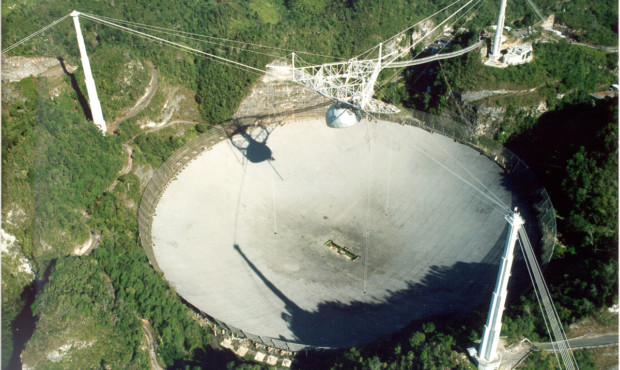Astronomers around world working to solve fast radio burst mystery
Aug 14, 2018, 3:04 PM

The Arecibo radio telescope in Puerto Rico is the world’s largest single antenna, with a million-watt transmitter. (AP Photo/Seth Shostak, SETI Institute)
(AP Photo/Seth Shostak, SETI Institute)
A strange cosmic phenomenon known as a fast radio burst (FRB) is a unique high-energy blast of particles, lasting only a few milliseconds on average.
There have been only some 35 examples of this type of energy to date, detected by some of the world’s most powerful radio telescopes.
What are these powerful blasts of cosmic energy, and where do they come from in space?
Astronomers around the world are working on the answer to this question. Using very powerful radio telescopes, these random signals, first detected in 2007 by astronomer Duncan Lorimer, have become one of the most amazing topics in all of astronomy.
FRB signals, also known as Lorimer Bursts, have been detected in random regions of the sky.
Modern physics tells us that these powerful signals are based around some type of intense magnetic field and may also be polarized as they travel out and away from the extragalactic source.
One FRB that has been discovered has a unique repeating signal associated with it.
Is the source of this energy a black hole, a neutron star or an advanced civilization trying to send out a message? No one knows for sure.
The first true Lorimer Burst is classified as FRB 010724, detected very close to the satellite galaxy of our Milky Way, the Small Magellanic Cloud. Atronomers feel that this first burst is not part of our own galaxy, but possibly from a source that is within 3 billion to 6 billion light years from Earth.
In 2010 there was a stream of potential FRB discoveries made by other radio telescopes around the world. To the surprise of many scientists, these were later discovered to be from local microwave ovens in the vicinity of the telescope. But that still leaves more than 35 FRB signals which appear to come from the deep dark depths of space.
FRB energy is found in the gigahertz region of the electromagnetic spectrum, but a recent detection by a Canadian radio telescope found an FRB source broadcasting in the lower frequency range of some 700 megahertz.
This discovery of FRB180725A is the first indication that there may be many more of these events occurring in the universe at many frequencies.
Some say that there may be some 10,000 or more of these events going on every day.
With the advance of higher technology in the form of more powerful radio telescopes, we are moving closer to an understanding of what the mechanism is that produces these intense bursts of energy.
Finally, FRB energy may be tied to the newly discovered concept of gravitational waves.
These are true ripples in the fabric of space-time.
Listen to Dr. Sky on KTAR News 93. FM every Saturday at 3 a.m.
To print your very own August 2018 star chart, click here.
To view satellites/dates/times of passage, click here.








